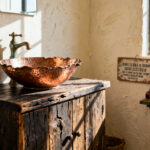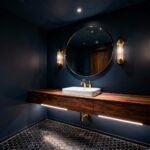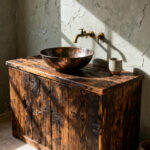Picture this: You’re standing in the kitchen of a 1920s bungalow. The morning light is filtering through a wavy, original windowpane, hitting the worn fir floorboards just so. You can feel the history, the solidness of the lath and plaster walls. It’s got soul. But let’s be honest, the layout is a nightmare. There’s about three feet of usable counter space, the sink is in a bizarre corner, and the whole room feels more like a cramped hallway than the heart of your home.
This is the central challenge—and the great joy—of living in a historic house. You’re a steward of its character, but you also need to, you know, actually cook dinner and live your life. Everyone seems to think the only solution is to blow out walls and create some giant, soulless open-concept space that looks like it belongs in a new-build suburb. They’re wrong. The real secret, the way to preserve the soul of the house while making it work for you, isn’t in demolition. It’s in smart, thoughtful furniture.
Foundations & Strategic Kitchen Furniture Planning
Before you fall in love with a freestanding butcher block or a set of vintage stools, we have to do the foundational work. This is the part everyone wants to skip, and it’s where all the most expensive mistakes are made. Getting this right means your kitchen will feel like it was always meant to be this way, a perfect collaboration between the home’s original builders and your modern life.
1. Assess Your Kitchen Layout for Optimal Furniture Placement
You know what people always ask me? “How do I create a work triangle in a kitchen that’s shaped like a bowling alley?” And I tell them to forget the rigid rules they read in a magazine. In a historic home, you’re not working with a blank slate; you’re working with a room that had a very different purpose a century ago. It might have been a small scullery, a service kitchen, or a space chopped up by a back staircase. The goal isn’t to force a modern layout onto an old footprint. It’s to understand the room’s quirks and use furniture to create functional zones.
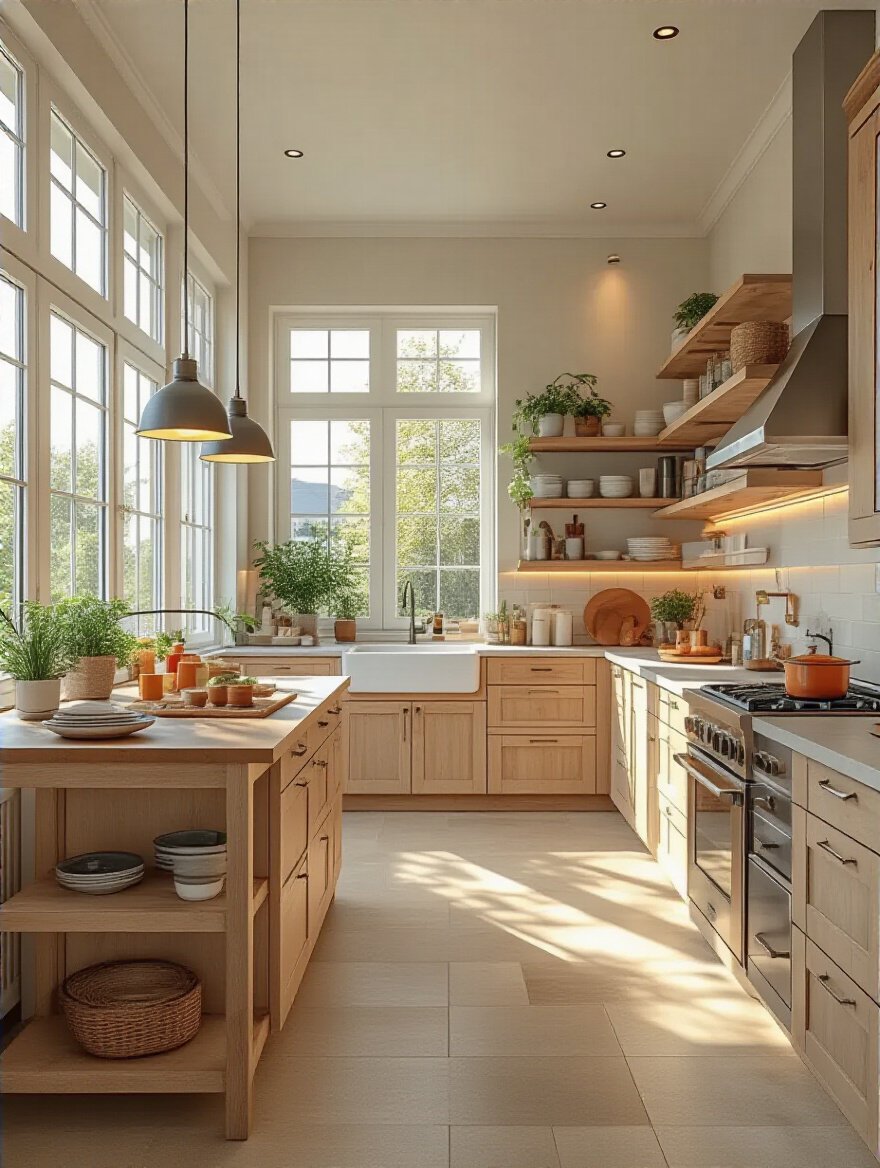
Start by looking for the room’s natural anchors—the original sink location, a sunny window, the built-in pantry cupboard that’s too beautiful to tear out. These are your non-negotiables. Then, think about the flow. Where do you walk in with groceries? Where do the kids drop their bags? You have to design for how you actually move through the space. Maybe a freestanding island isn’t the answer, but a narrow work table against a long wall creates a perfect prep zone without blocking the path from the stove to the back door. It’s about respecting the bones of the house and creating a dance, not a wrestling match.
This initial assessment is your roadmap. Get it right, and every piece of furniture will feel like it belongs.
2. Precisely Measure Your Space to Maximize Furniture Fit
I used to think measuring a room was simple. Then I started working exclusively on houses built before 1940. I learned very quickly that in an old house, there are no straight lines, no level floors, and no perfectly square corners. The plaster walls bow, the floors have settled into a gentle slope, and the ceiling might be an inch lower on one side of the room than the other. If you take one measurement and order a custom piece, I can almost guarantee it won’t fit.
This is why “measure twice, cut once” is an understatement. You need to measure three times: once at the bottom, once in the middle, and once at the top of every wall or opening. I once watched a client nearly lose their mind because the beautiful, thousand-pound soapstone island they ordered was a half-inch too wide to fit through the kitchen doorway. They measured the middle of the door, not the narrowest point near the hinge. It was a costly, soul-crushing mistake. Get yourself a good laser measure; it’s invaluable for this. And always, always make a template out of cardboard or painter’s tape on the floor. Live with it for a day. You’ll be shocked what you notice.
These little eccentricities are part of the charm, but only if you plan for them from the very beginning.
3. Define Your Kitchen’s Primary Purpose for Functional Choices
The original kitchen in your Victorian or Craftsman home was designed as a utilitarian workspace, often hidden from the rest of the house and used by servants or a lone cook. It wasn’t a place for homework, for hosting a party, or for catching up on emails. But yours is. Defining its purpose today is about reconciling the home’s history with your modern reality. You have to be honest with yourself about what you actually do in your kitchen.
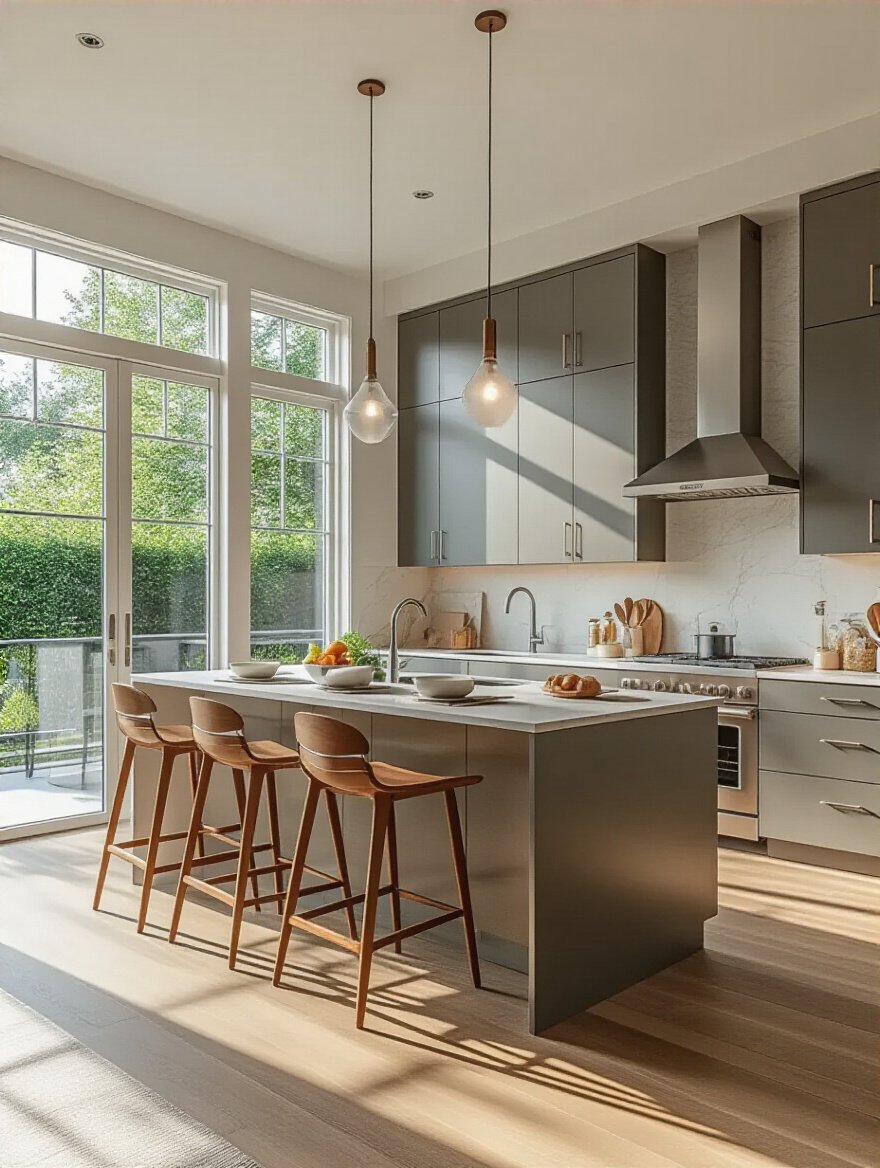
Are you a baker who needs a lower, marble-topped surface for rolling out dough? Is your kitchen the family command center where art projects and conference calls happen simultaneously? Or is it a quiet space where you and your partner cook together in the evenings? The answer dictates the furniture. The baker needs a sturdy work table. The family command center needs a durable, forgiving island with comfortable seating and built-in outlets. The couple might want a smaller bistro table in a sunny corner instead of island seating. Don’t design for a fantasy life; design for the one you have.
This is how you create a kitchen that feels not just beautiful, but deeply personal and effortlessly useful.
4. Establish a Realistic Furniture Budget for Cost-Effective Solutions
Can we talk about why so many people get this wrong? They’ll spend a fortune on custom cabinetry and high-end appliances, and then try to cheap out on the furniture. The result is a beautiful space that feels strangely hollow, punctuated by a flimsy table or wobbly, mass-produced stools. In a historic home, quality and substance matter. The craftsmanship of your furniture needs to be able to stand next to original, 100-year-old millwork and not look ridiculous.
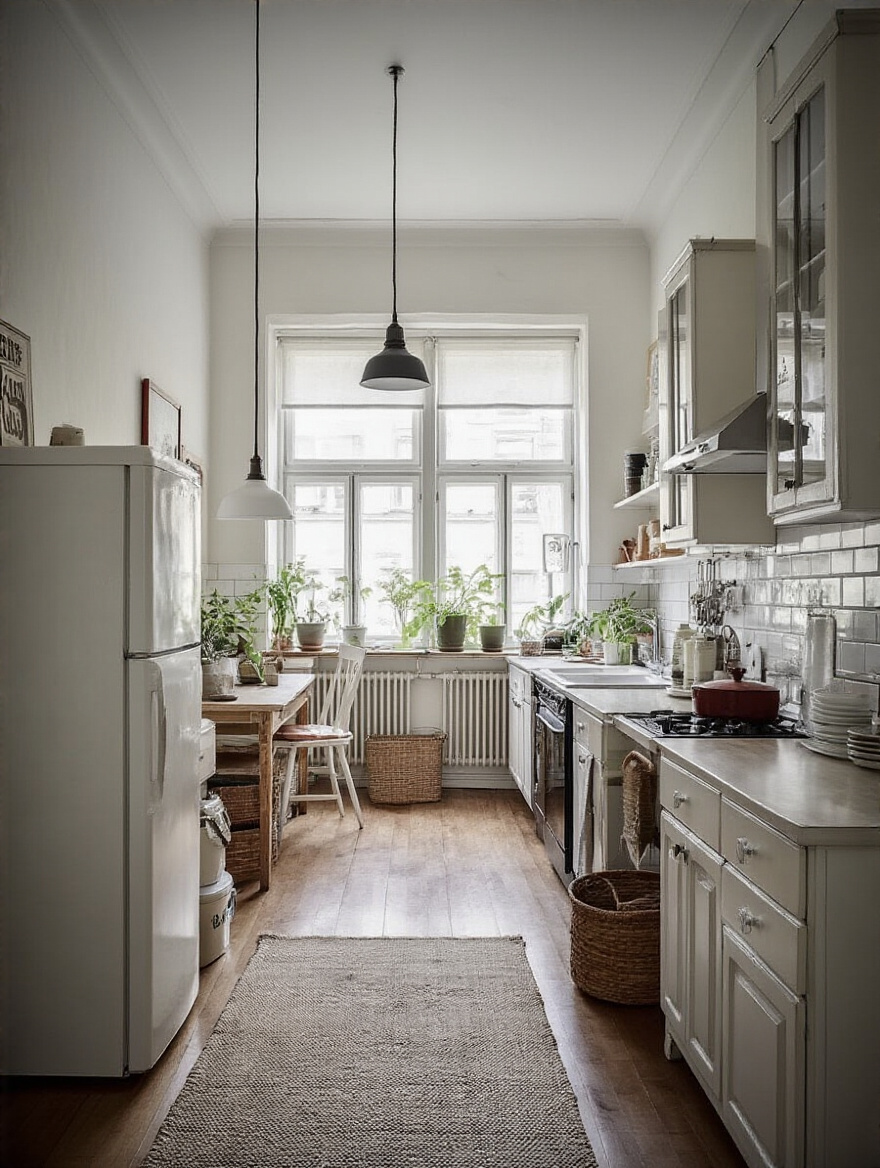
A realistic budget isn’t about finding the cheapest option; it’s about allocating funds for pieces that will last and will honor the integrity of your home. This might mean investing in one spectacular piece—like a solid maple butcher block island made by a local craftsman—and saving elsewhere. It means budgeting for the longevity of solid wood, the authenticity of natural stone, and the durability of good joinery. You are far better off buying a high-quality vintage piece that needs a little love than a brand-new, particleboard item that will fall apart in five years.
Your budget should reflect the value you place on craftsmanship—the very thing that drew you to an older home in the first place.
5. Anticipate Future Needs for Flexible Furniture Adaptability
When you own a historic home, you’re not just an owner; you’re a steward. The choices you make will affect the house long after you’re gone. So, when choosing kitchen furniture, think about adaptability. The monolithic, 12-foot island with three built-in sinks and a wine fridge might seem like a great idea now, but it’s a permanent, trend-driven decision that a future owner (or even you, ten years from now) might hate and find incredibly difficult to remove.

Instead, prioritize furniture that offers flexibility. A beautiful freestanding island can be moved or replaced. A well-made pantry cabinet can be taken with you when you move. Think in terms of “reversible” changes. How can you add function for your family today without permanently scarring the house? Maybe it’s not a built-in banquette, but a beautiful church pew you found at an antique market paired with a simple table. This approach gives you the utility you need while preserving the home’s original footprint and architectural integrity.
Think of it as a conversation with the house. You’re adding your chapter, not trying to erase the ones that came before.
Essential Functional Kitchen Furniture Solutions
Alright, with the planning done, we can get to the good stuff: the actual pieces that will transform your kitchen. These aren’t just about looks. Each of these solutions is a workhorse, designed to solve the common problems of older kitchens—lack of storage, awkward layouts, and not enough workspace.
6. Choose Right-Sized Kitchen Islands for Enhanced Workspace
Everyone says you need a massive kitchen island, but here’s what actually happens: in a smaller historic kitchen, a giant island becomes a roadblock. It kills the flow and makes the room feel cramped and awkward. I’ve seen clients install huge, cabinet-laden islands only to realize they can’t fully open their oven or refrigerator doors. It’s a disaster. In most older homes, what you really need isn’t an island; it’s a work table.
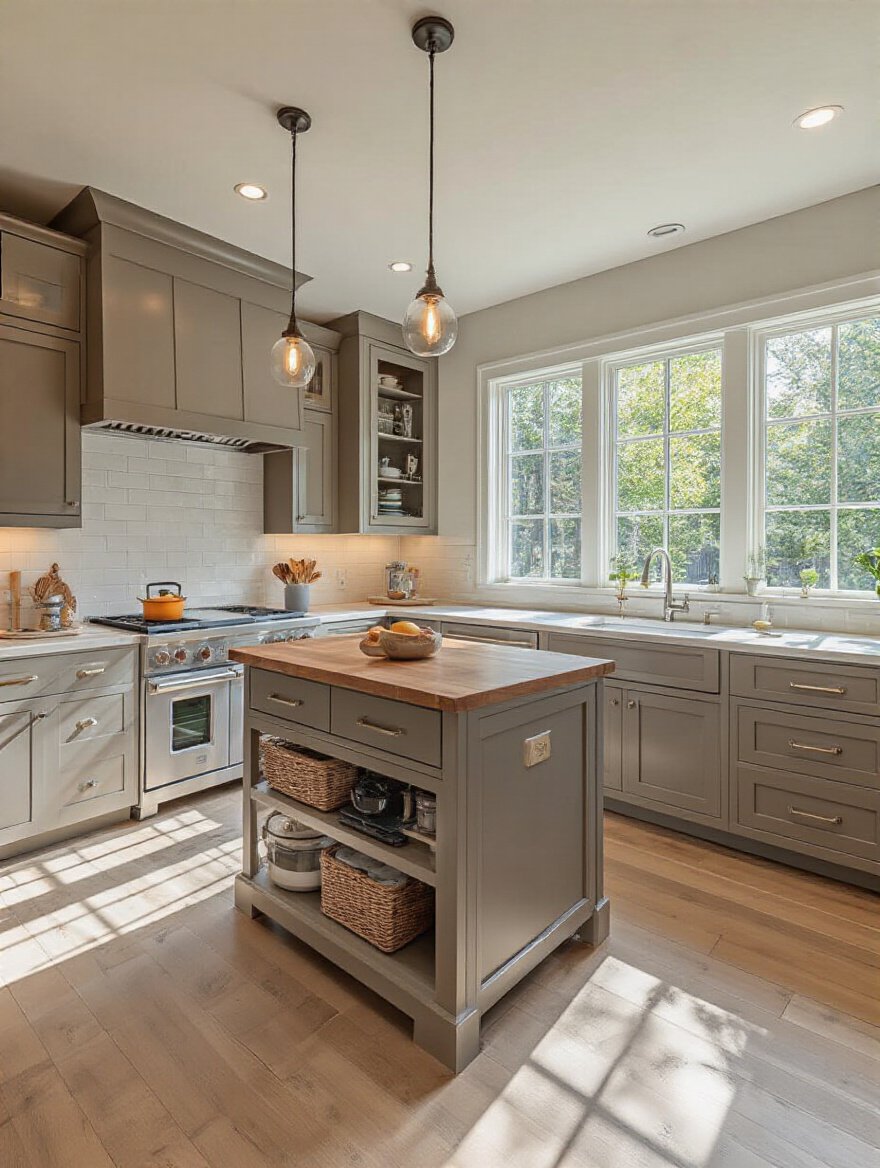
Think of the classic scullery or farmhouse kitchen. The centerpiece was a sturdy, freestanding table. It provides that crucial prep space, but because it has legs instead of a solid base, it keeps the room feeling open and airy. You can see the beautiful original floorboards underneath. A simple butcher block or a marble-topped table is often the perfect solution. It gives you workspace and a place to gather without visually or physically consuming the entire room. It’s a period-appropriate solution that is infinitely more graceful than trying to cram a suburban-sized island into a 1910 kitchen.
This approach gives you the function you need while respecting the original scale and spirit of the room.
7. Integrate Clever Pantry Cabinets for Organized Food Storage
The modern obsession with cavernous, walk-in pantries is a tough one to achieve in most historic homes without massive, soul-destroying renovations. The good news is, you don’t need one. The original solution was often better: the freestanding pantry cabinet. Think of a classic “Hoosier” cabinet or a tall, handsome cupboard. These pieces are furniture, not construction. They provide an incredible amount of smart, zoned storage in a compact footprint.

I once worked with a family in a Victorian that had a perfectly good kitchen, just no storage. Instead of a costly renovation, we found a beautiful antique pine cupboard for $400. We had it fitted with new interior shelving and pull-out drawers. It instantly solved their storage problem, became a gorgeous focal point, and added a layer of history and character that new built-ins never could. Look for a forgotten closet you can outfit with shelves or find a beautiful freestanding piece. It’s a less invasive, more authentic, and often cheaper way to get the storage you crave.
It’s a solution that works with the house, not against it.
8. Select Multi-Functional Base Cabinets for Optimal Organization
If you’re lucky enough to have original cabinetry, the last thing you want to do is tear it out. That beautiful beadboard detailing, the simple Shaker doors, the patina of a hundred years of use—you can’t buy that. But let’s be honest, a deep cabinet with one fixed shelf is a black hole where Tupperware goes to die. The shortcut you need to know is retrofitting. You can keep the historic soul and get modern function.
This is my favorite trick. You carefully remove the doors, and then you can install modern, full-extension pull-out drawers and organizers inside the original cabinet box. We do this all the time. The client gets heavy-duty, soft-close drawers for all their pots and pans, but from the outside, the kitchen looks completely untouched. It is the absolute best of both worlds. You preserve the irreplaceable craftsmanship of the past while eliminating the daily frustration of digging around on your hands and knees.
This preserves the character of your home while making it work for the 21st century.
9. Explore Open Shelving for Accessible Storage and Display
Can we just talk about why everyone gets open shelving wrong? They see these pictures in magazines of pristine, minimalist kitchens with a few artfully placed white bowls on a floating shelf. What they don’t show you is the layer of greasy dust that collects on everything if that shelf is anywhere near the stove, especially in an older home that may not have modern, high-powered ventilation. It can be a maintenance nightmare.
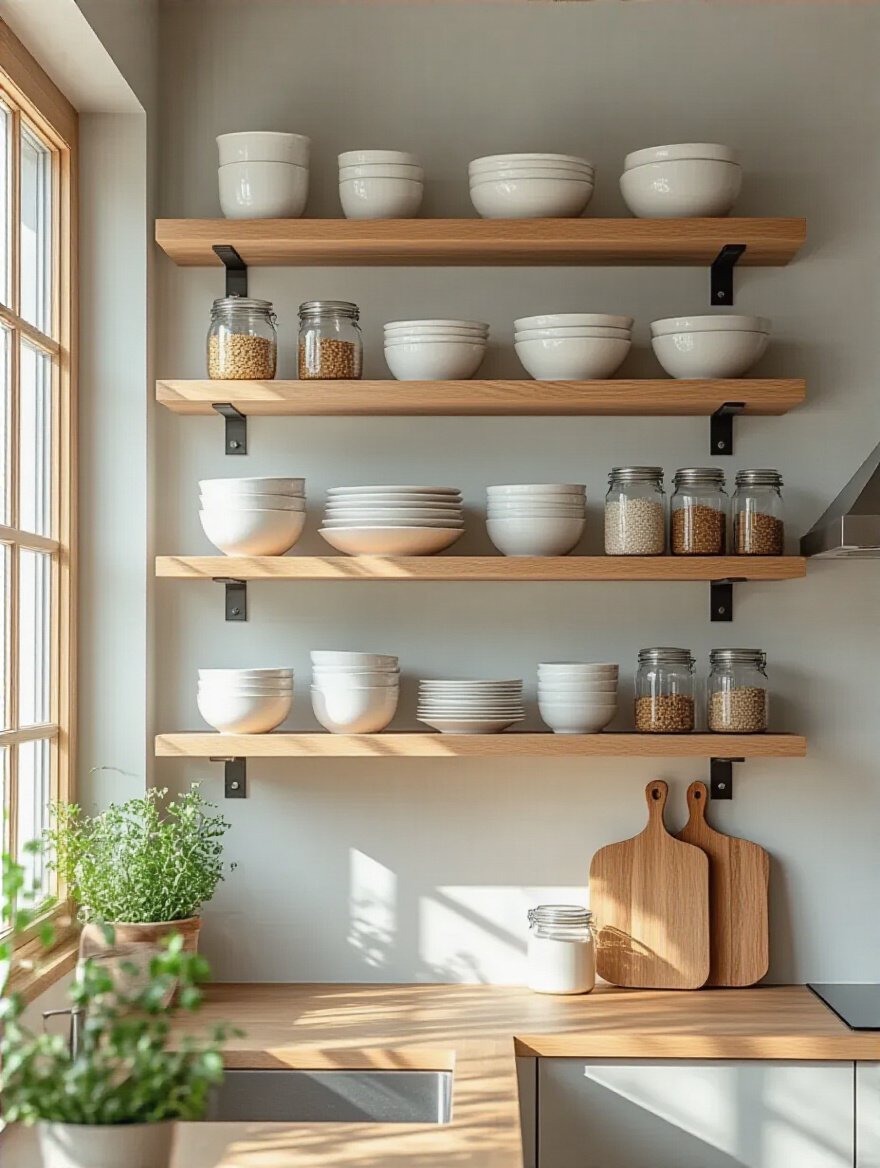
I’m not against open shelving, but it has to be done with intention and in the right place. A few sturdy shelves made from reclaimed wood that matches the house’s original trim can look fantastic holding your everyday dishes, but place them away from the primary cooking zone. Even better, consider using a freestanding piece like a Welsh dresser or a baker’s rack. This gives you that open, accessible display without committing to drilling a bunch of holes in your historic plaster walls. It’s a more flexible and often more period-appropriate way to get the look.
It’s about being realistic about how you live and the realities of a kitchen environment.
10. Utilize Bar Stools for Comfortable Countertop and Island Seating
Once you’ve chosen your work table or island, the seating is what turns it from a purely functional surface into a social hub. But please, don’t just order the first generic, backless metal stool you see online. The style of the stool is a powerful signal. It’s a detail that can either harmonize with your home’s character or clash horribly with it.
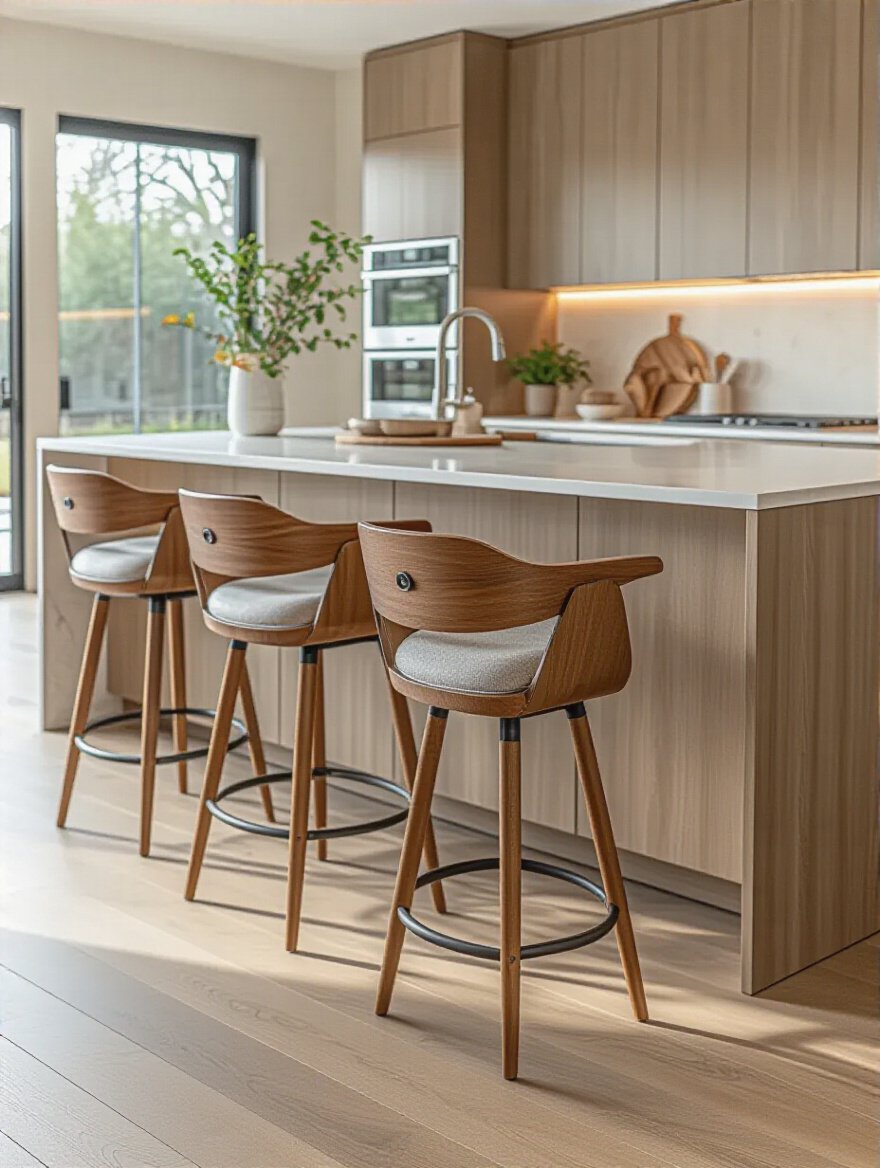
For a Colonial or farmhouse-style home, think about classic Windsor-style stools with their elegant, turned legs. In a Craftsman bungalow, a simple, sturdy oak stool with clean lines, maybe in the Stickley style, would be perfect. For a mid-century home, a sleek bentwood or molded fiberglass design is the obvious choice. The goal is to find a form that echoes the architectural language of your house. It’s these thoughtful details that make a restoration project feel complete and authentic, not just like a collection of random parts.
Function is key, but in a historic home, form and context are what tell the story.
Smart Space Utilization & Workflow Optimization Ideas
Now we’re getting into the clever solutions. These are the ideas that solve the really specific problems of older homes—the weird corners, the lack of floor space, the nooks and crannies that seem useless. This is where furniture becomes a problem-solver.
11. Deploy Rolling Kitchen Carts for Portable Prep Zones
If there is one piece of furniture I recommend for almost every old-house kitchen, it’s a rolling cart or a small butcher block on casters. It’s the ultimate secret weapon for small or awkwardly shaped rooms. It’s a portable prep station, a temporary landing spot for groceries, a bar cart when you’re entertaining—it’s whatever you need it to be, right where you need it.

I worked on a tiny galley kitchen in a 1930s apartment where there was literally no free counter space. We found a small vintage industrial cart with a butcher-block top. The client kept it tucked away in a corner, and when she was ready to cook, she’d roll it out next to the stove. It instantly gave her two feet of prime workspace. When she was done, it rolled back out of the way. It’s a solution that adds immense function without any permanent alteration to the room. It’s pure flexibility, and it allows a small kitchen to perform like a much larger one.
This is the kind of adaptable solution that makes living in a smaller, historic space a joy instead of a compromise.
12. Add Built-In Banquette Seating to Optimize Dining Nooks
So many early 20th-century homes have them: the charming little breakfast nook. They were designed for small tables and chairs, but a built-in banquette is often a far better use of the space. It can double your seating capacity and, more importantly, it can provide an enormous amount of hidden storage. A simple, well-designed banquette is a classic, period-appropriate choice.
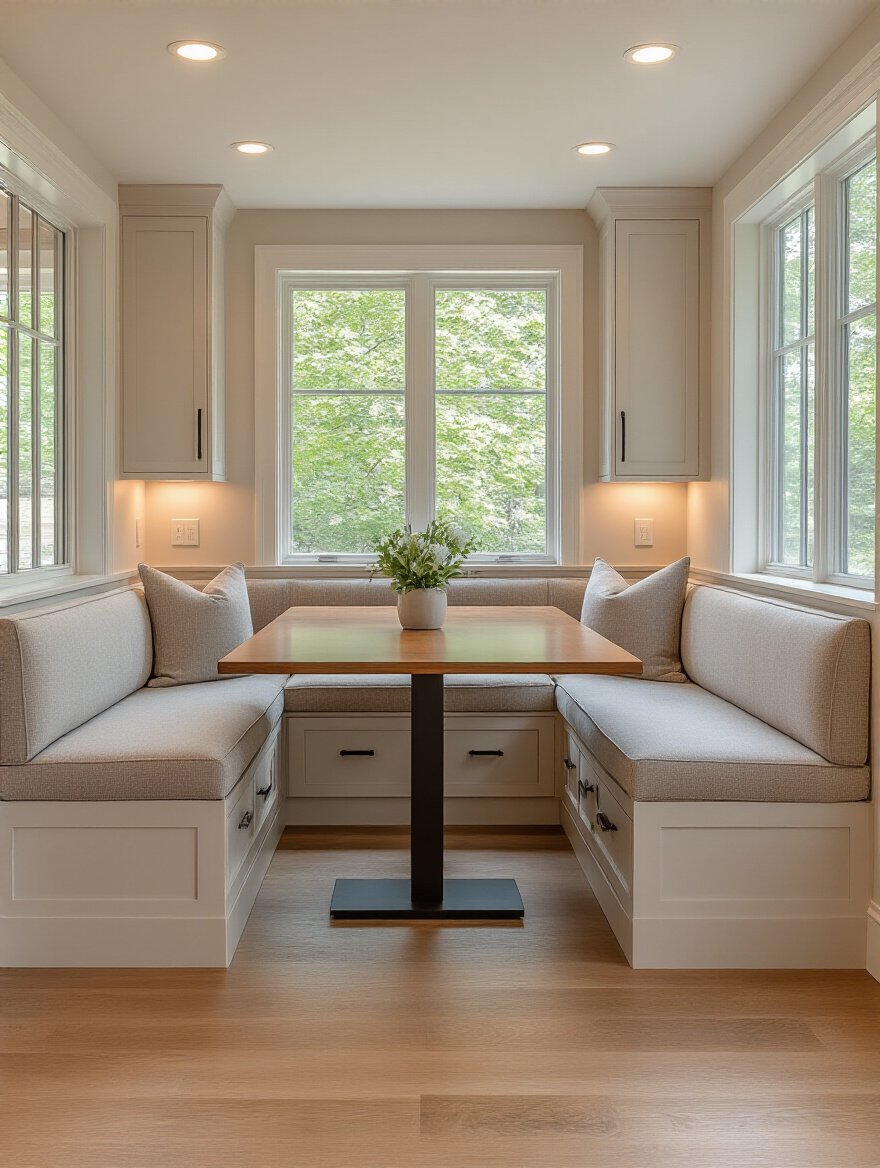
When we build these for clients, we always look to the home’s existing architectural details for cues. In a Craftsman home, we might use simple, flat-panel doors for the base. In a Colonial Revival, beadboard is the perfect choice. The key is to make it look like it was always there. The hinged tops open up to reveal storage for bulky kitchen appliances, seasonal linens, or kids’ craft supplies. It clears your countertops and organizes your life while creating a cozy, inviting spot for family meals.
It’s an architectural solution that feels both timeless and incredibly practical.
13. Install Wall-Mounted Foldable Tables for Small Spaces
I’ll confess, I used to think wall-mounted tables were a bit flimsy and modern for most of the projects I work on. Then, a client with a tiny former butler’s pantry showed me how she’d used one. She had installed a beautiful piece of solid cherry on heavy-duty, cast-iron folding brackets. When it was down, it looked like a handsome shelf. When it was up, it was a sturdy dining table for two. It was brilliant.
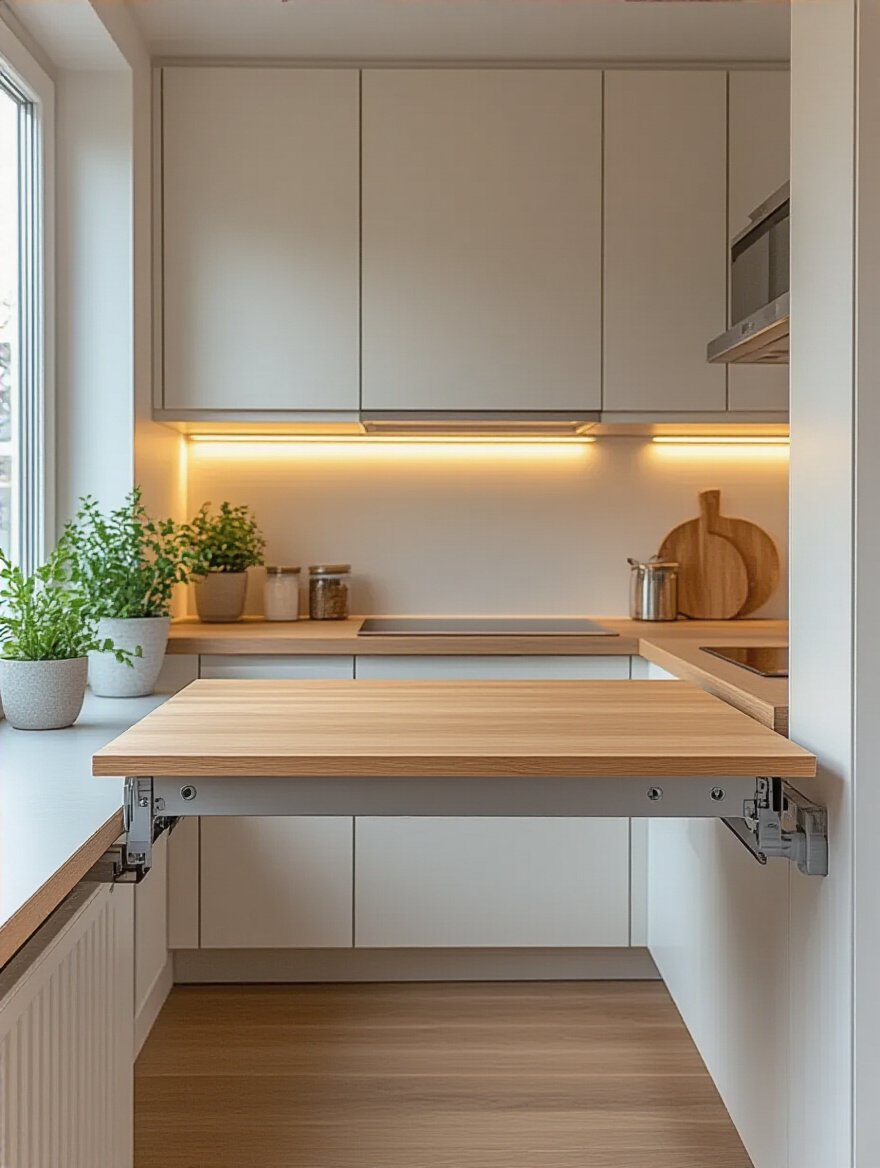
This is the modern evolution of the classic drop-leaf table. It’s the perfect solution for the tiniest of spaces—the back mudroom, the landing at the top of the stairs, or that odd, narrow part of the kitchen that can’t fit a real table. It allows a single space to serve multiple functions. Paired with a couple of simple, stackable chairs, it’s an instant eat-in kitchen that disappears when you need the floor space back. Just make sure you invest in high-quality brackets and anchor them directly into the wall studs. This is not a place to skimp.
It’s proof that even the most challenging spaces can be made wonderfully functional with a little ingenuity.
14. Incorporate Customizable Pull-Out Drawers to Reduce Clutter
This is another ode to retrofitting. You have your beautiful, original cabinets. You want to make them more functional without ruining them. We’ve talked about pull-outs, but here’s the hard lesson I learned: off-the-shelf pull-out systems from big-box stores are designed for modern, standardized cabinet sizes. They almost never fit properly in older, custom-built cabinetry where the interior dimensions can be quirky and inconsistent.
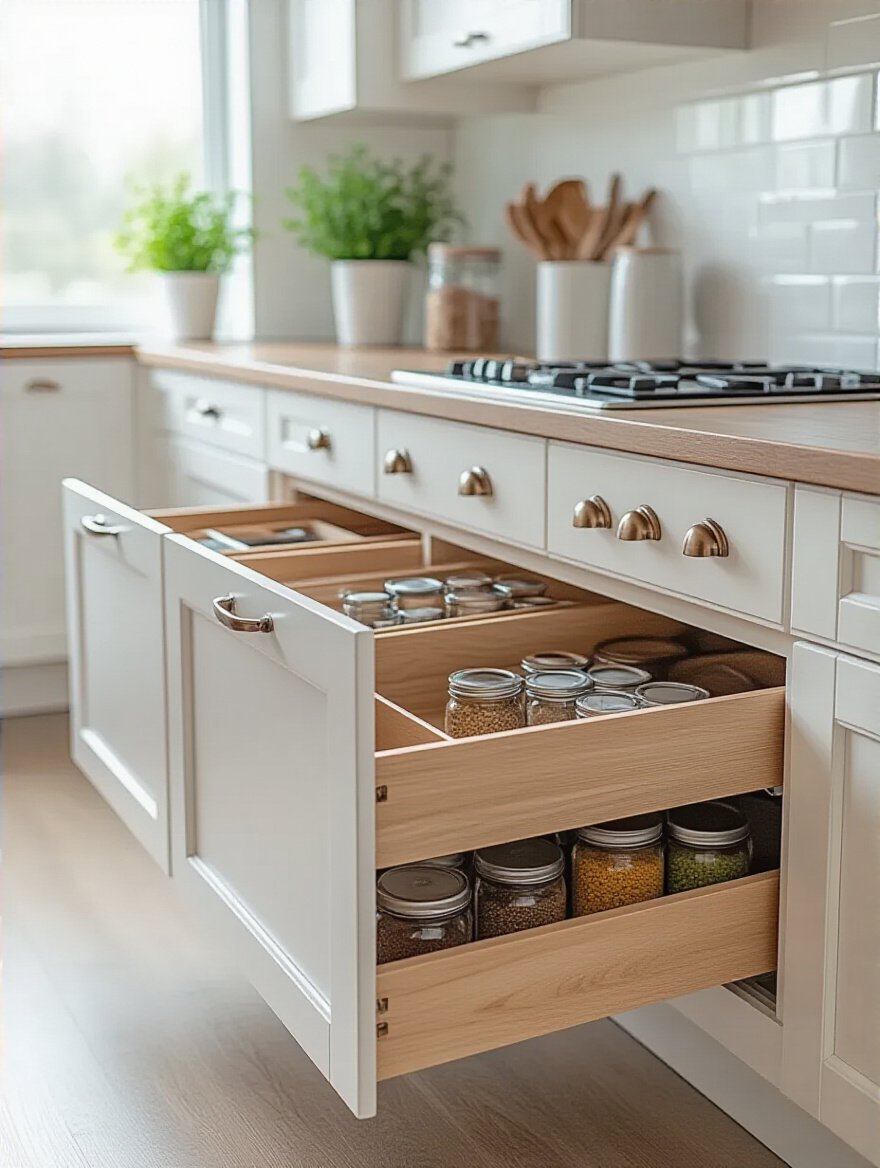
The solution is to find semi-custom or custom systems. There are companies that will build wire or wood pull-out drawers to your exact specifications. It’s more expensive than the DIY kits, yes, but it will actually fit and function smoothly. The other option is to have a good carpenter build simple wooden boxes on full-extension slides. The goal is to get 100% access to that deep, dark space. When you can see everything you own, from spices to small appliances, your kitchen immediately feels more organized and less cluttered.
It’s a functional upgrade that pays dividends every single day.
15. Select Corner Cabinet Solutions to Utilize Awkward Spaces
Ah, the dreaded corner cabinet. In a modern kitchen, this is where you’d find a complex, spinning Lazy Susan or a pull-out contraption. In an old kitchen, these often don’t fit or feel jarringly out of place. My advice? Don’t try to force a modern solution into a historic space. Instead, look to historic solutions. My favorite is the freestanding corner cabinet.
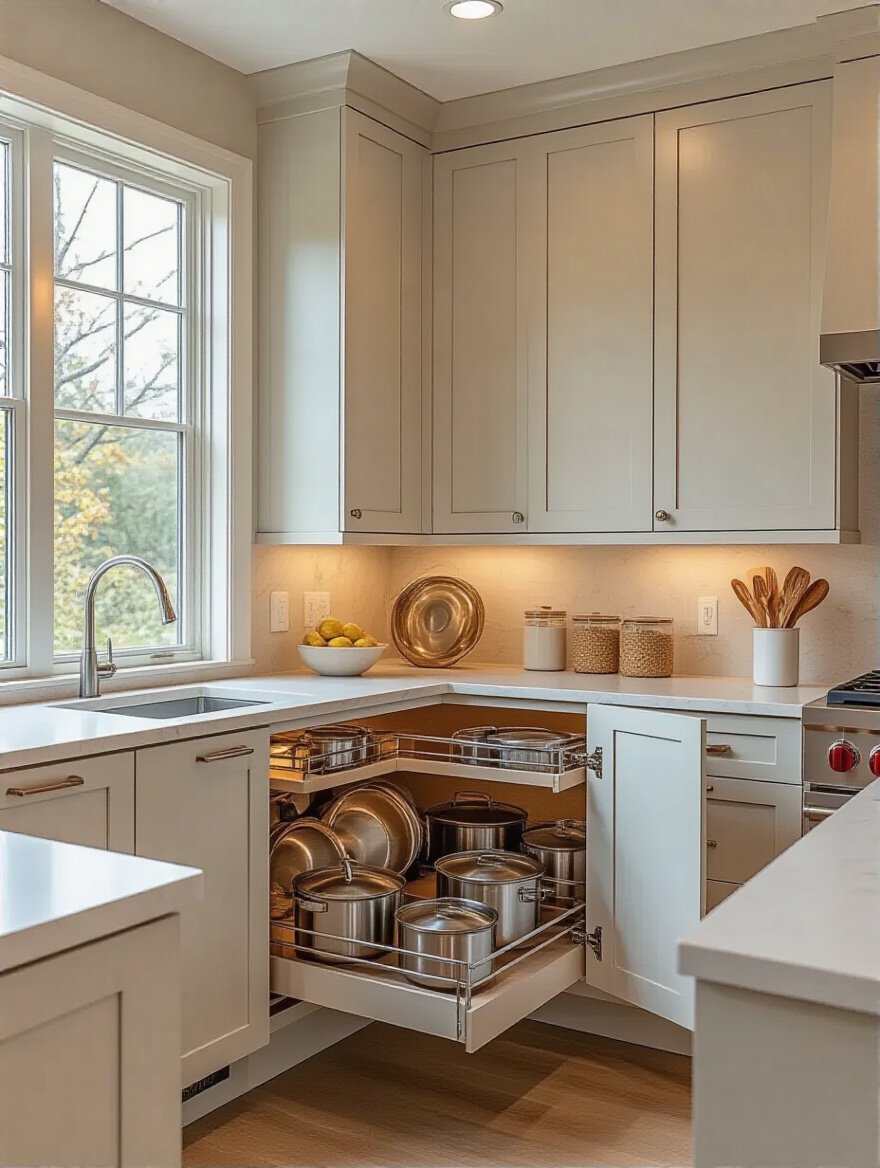
For centuries, this was the elegant answer to the awkward corner. A tall, handsome corner cupboard provides an incredible amount of storage and display space while fitting neatly out of the way. It becomes an architectural feature in its own right. I’ve seen clients use them for everything from pantry goods to their grandmother’s china. It’s a piece of furniture, not a built-in, so it feels lighter and more authentic. You can find beautiful antique ones, or have one built to match your home’s style. It’s a classic, beautiful solution that is infinitely more graceful than a clunky plastic carousel.
Sometimes the oldest solutions are still the best.
Elevating Kitchen Aesthetics & Personal Style Through Furniture
We’ve covered function. Now let’s talk about the soul. The furniture you choose is your chance to add your own layer to the home’s story. It’s how you make the kitchen feel like yours, blending your taste with the home’s inherent character to create something truly special.
16. Harmonize Furniture Styles with Your Existing Kitchen Decor
The most beautiful historic interiors are rarely period-perfect museums. They are layered. They show a thoughtful conversation between different eras. Your kitchen should be the same. You don’t need to furnish your 1890s kitchen with only 1890s furniture. The key to making a mix of styles work is finding a common thread.
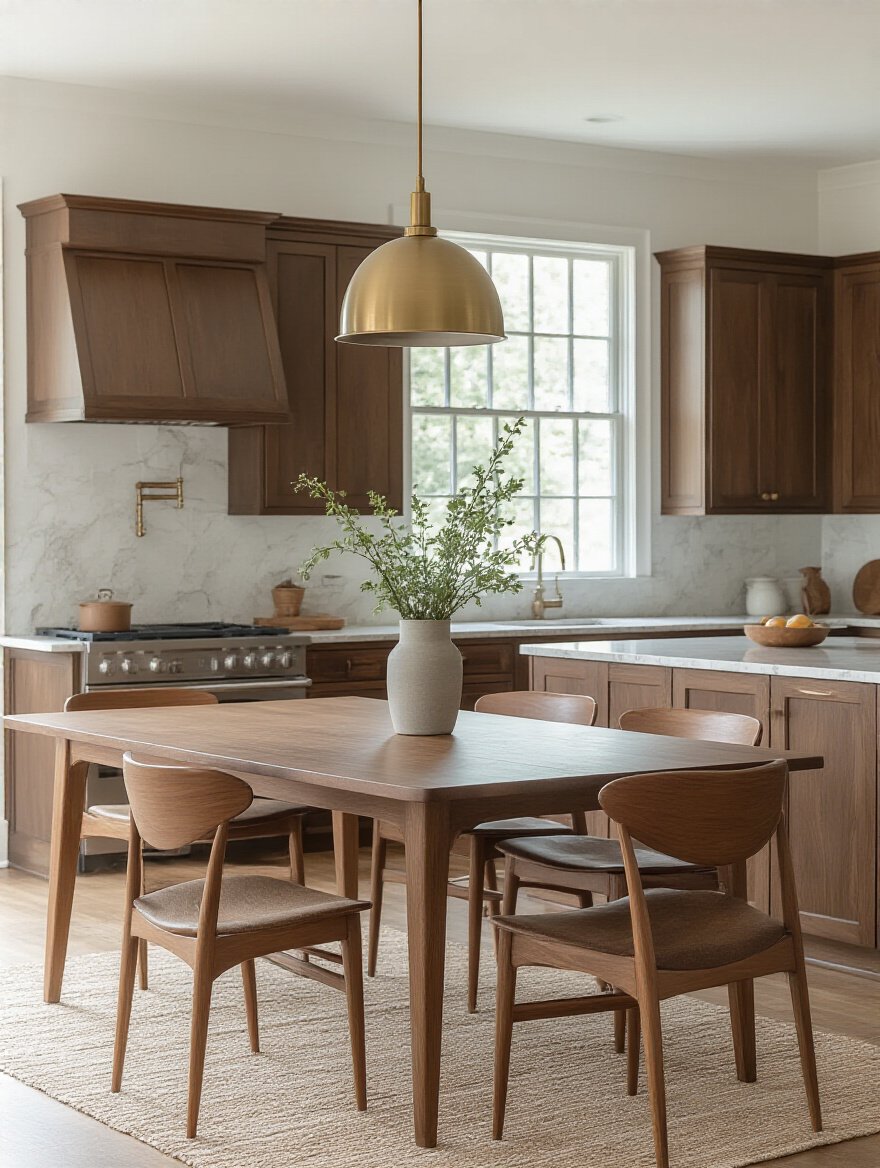
Maybe you have a rustic, 19th-century pine work table as your island. You can absolutely pair that with sleek, modern metal stools if you echo that metal finish in your pendant lights or cabinet hardware. The harmony comes from connecting materials, colors, or textures. A simple rule is to stick to one or two primary materials (like oak and soapstone) and one accent metal (like unlacquered brass). This creates a cohesive palette that allows you to play with the form and period of individual pieces without the room descending into chaos.
It’s this intentional, curated blend that gives a room depth and personality.
17. Select Durable Furniture Materials for Longevity and Beauty
In a house built to last for centuries, choosing furniture made from particleboard and plastic veneers is a tragedy. The materials you bring into your kitchen should have the same integrity as the house itself. Think solid wood, real stone, and honest metals. These materials aren’t just durable; they have character. They age gracefully and develop a patina that tells a story.

A maple butcher block will show the marks of a million meals prepared. A marble countertop will get little etches and stains that mark memories of spilled wine and family dinners (if you can’t embrace that, choose quartz or soapstone!). Unlacquered brass hardware will darken and soften with time and touch. These are not flaws; this is life. This is what gives a space soul. Investing in quality, natural materials is an investment in beauty that will last for decades, not just until the next trend comes along.
Choose materials that are worthy of the home they inhabit.
18. Use Accent Furniture Pieces to Create Visual Focal Points
Every room needs a star, a single piece that draws your eye and sets the tone. In a kitchen that might be filled with simple, functional cabinetry, an accent piece of furniture is the perfect way to create that focal point. And in a historic home, there’s no better source for this than antique or vintage finds. A painted jelly cupboard, a rustic pie safe, or an old general store counter repurposed as an island—these pieces bring an instant layer of history and narrative.

I once found a stunning, but very beat-up, 19th-century Welsh dresser for a client’s farmhouse kitchen. It was missing some trim and the finish was shot. We had it carefully restored and painted a deep, moody blue. Placed against a simple white wall and filled with their everyday dishes, it became the heart and soul of the entire space. It provided much-needed storage, but more importantly, it provided a story. You can’t get that feeling from a showroom.
Look for a piece with history, a piece that has already lived a life before it came to you.
19. Prioritize Strategic Lighting to Enhance Furniture Features
You can have the most beautiful furniture in the world, but if your lighting is bad, your kitchen will feel grim and flat. Older homes are notoriously under-lit, often having just a single, sad fixture in the middle of the ceiling. The key to fixing this is layering. You need three types of light: ambient (for overall illumination), task (for workspaces), and accent (to highlight your beautiful furniture).
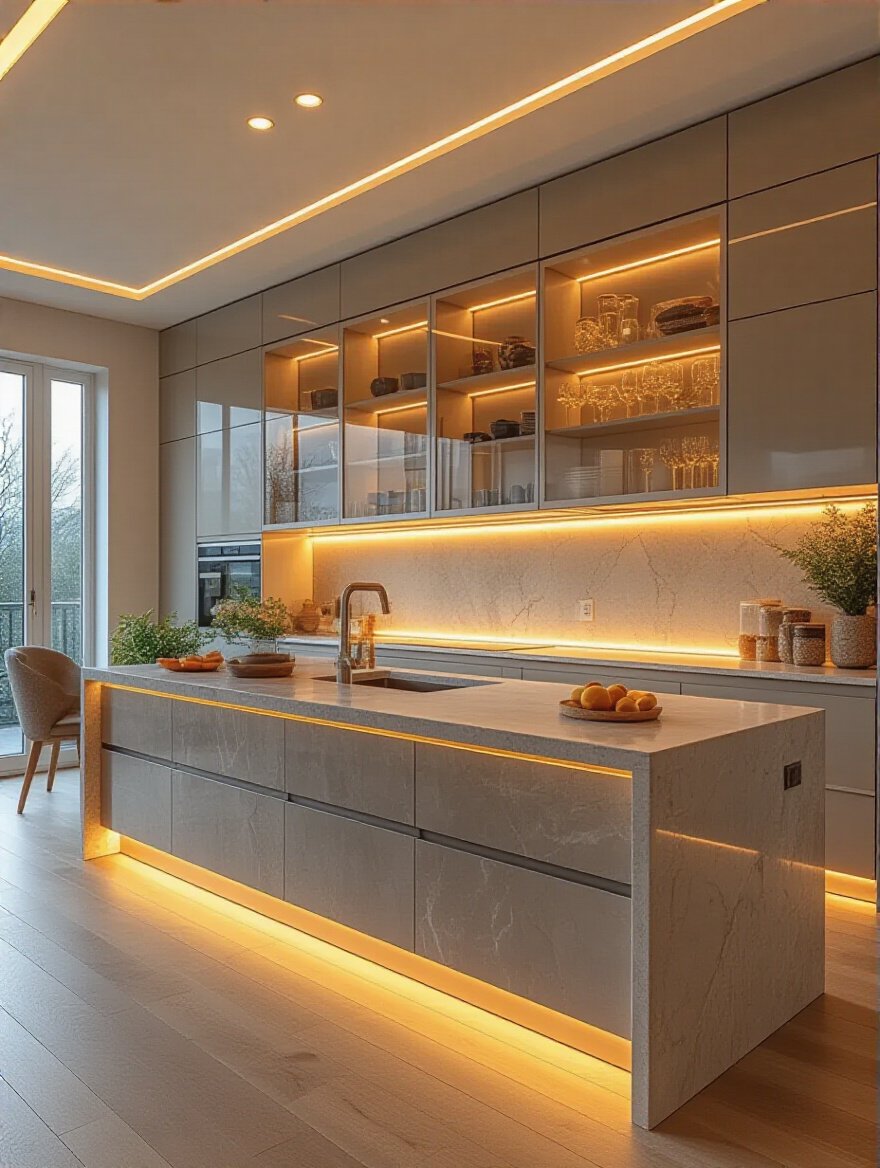
For ambient light, a beautiful, period-appropriate fixture (like a schoolhouse semi-flush mount or a classic lantern) sets the tone. For task lighting, nothing beats discreet, under-cabinet LED strips. They are modern, yes, but they are nearly invisible and absolutely transform your workspaces. And finally, for accent lighting, consider a pair of handsome sconces flanking a freestanding pantry cabinet, or a single, beautiful pendant hanging low over your work table. This focused light draws attention to your key furniture pieces and creates a warm, inviting glow in the evening.
Good lighting is the final touch that makes all your other choices shine.
Conclusion
Your kitchen is not just a room; it’s the engine and the heart of your home. And in a historic house, it’s a space that holds generations of stories. The goal of any renovation or update shouldn’t be to erase that history, but to add your own chapter in a way that respects everything that came before. Furniture is your most powerful tool to do this. It allows you to introduce modern function without sacrificing historic character, to solve practical problems while adding layers of beauty and personality.
By planning strategically, choosing pieces with integrity, and focusing on quality materials, you can create a kitchen that is a true collaboration between the past and the present. You can have a space that works beautifully for your modern life while still whispering the stories of the families who cooked there a century ago. It’s about being a thoughtful steward, a creative problem-solver, and a curator of a space that is uniquely, authentically yours. Now go build the kitchen your beautiful old house deserves.


